Routing Number, Transit & Institution Codes in Canada
Need to set up a direct deposit or pay an insurance premium? Learn how to locate your Canadian routing number, including transit and institution codes, with ease.
📖 7 Minute Read
📅 Originally Published: January 2024
🔄 Updated: June 9, 2025

Routing Number, Transit & Institution Codes in Canada
Need to set up a direct deposit or pay an insurance premium? Learn how to locate your Canadian routing number, including transit and institution codes, with ease.
📖 7 Minute Read
📅 Originally Published: January 2024
🔄 Updated: June 9, 2025

After you’ve found and applied for a life insurance policy or opened an investment account, you may be asked for your bank routing number by your insurer. But what exactly is a routing number in Canada, and how and where do you find your transit and institution codes? Whether you’re filling out a direct deposit form or setting up an automatic withdrawal, having the right numbers matters.
In this guide, you’ll discover the difference between routing, transit, and institution numbers, how to locate them on a cheque or through your bank — and why correct formatting matters when applying for insurance or managing your finances.
In this article:
- What is a routing number?
- Routing number vs transit number vs account number
- When do I use my routing number?
- How to find your routing number using a cheque
- How to find your routing number if you don’t have a cheque
- How to find your routing number using your bank address
- Routing Number Directory by Payments Canada
- How to find your transit number, account number, and institution number
- How to find your Institution Number
What is a routing number?
A routing number in Canada is a unique code made up of 8 or 9 digits. It’s used to identify both your financial institution and the specific branch tied to your account. It includes:
the 5-digit branch number (also called the transit number) and a 3-digit institution number.
To read or generate your Canadian routing number, combine your transit number with your institution number. For example, TD’s branch at 394 Bay Street in Toronto has a transit number of 12162 and an institution number of 004. The full routing number is 12162-004.
Not sure where to find these numbers? We’ve broken it all down for you below. You’ll learn how to read your cheque, find your bank’s numbers online, and avoid mistakes when setting up insurance or automatic premium withdrawals.
Routing number vs Transit number vs Account number
In Canada, your bank routing number combines two key pieces of information: your transit number and your financial institution number. The transit number identifies your specific branch location, while the institution number identifies your bank. You can find your transit number by searching your bank branch online or by checking the bottom of a cheque.
Your account number is different. It’s a unique 7- to 12-digit number tied specifically to your bank account. This number directs where funds go when money is deposited or withdrawn, and it’s required for any type of automatic withdrawal or insurance premium payment. For example, insurance companies use both your routing number and account number to ensure they’re accessing the correct account when setting up automated premium payments.
When do I use my routing number?
When you apply for life insurance, you’ll often be asked to provide your routing number and account number as part of the delivery receipt process. This typically happens once your policy is approved and you’re ready to accept the offer.
At that point, you’ll complete a Pre-Authorized Debit (PAD) or Pre-Authorized Cheque (PAC) form. These are both types of Automated Funds Transfers (AFTs) that rely on your routing number to correctly identify your bank and branch. This ensures that monthly insurance premiums are withdrawn from the right account without interruption.
How to find your routing number using a cheque
Even if you haven’t heard the term routing number before, you’ve likely seen it printed on your cheques. Along the bottom of every Canadian cheque, you’ll find your routing number and account number — displayed in a special font for machine reading.
These numbers are separated by symbols that help differentiate each code.
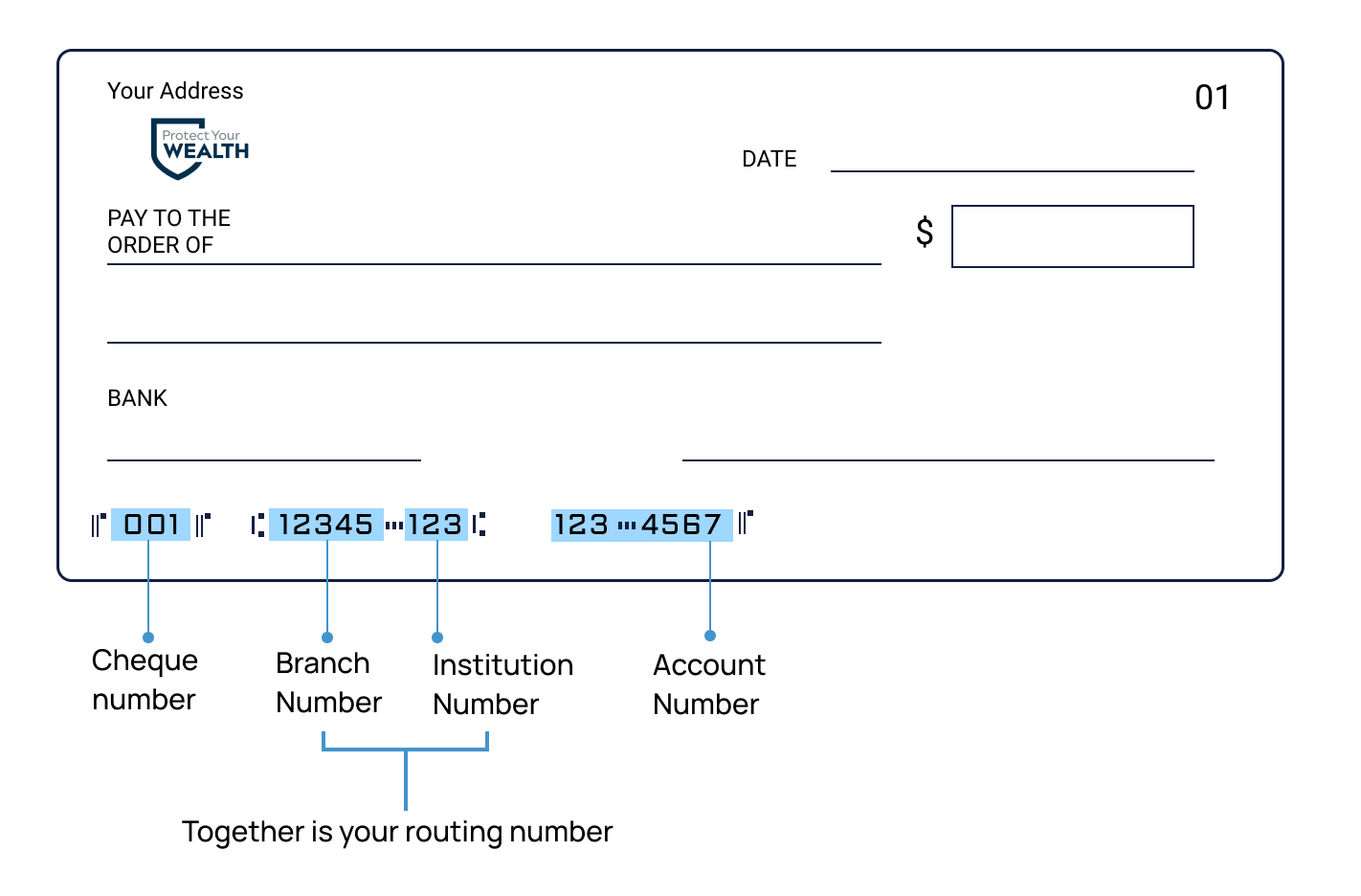
From left to right, the numbers on a cheque usually appear in this order:
- The cheque number
- The transit (branch) number
- The institution number
- Your account number
If you’re unsure which number is which, knowing your bank’s institution number can help. It allows you to spot where the transit number ends and where the account number begins. Even if the numbers are separated by routing symbols, the institution number usually appears closely grouped with the transit number.
💡 Did you know? Your routing number is a combination of your 5-digit transit number and 3-digit institution number. Together, they identify your exact branch location.
How to find your routing number if you don’t have a cheque
If you don’t have access to a physical cheque, don’t worry. There are still several reliable ways to locate your Canadian routing number through your bank’s digital tools. Most major banks and credit unions provide this information in your online banking portal or mobile app.
The fastest option is to download a void cheque or direct deposit form from your online banking account. These documents will show your transit number, institution number, and account number, which together make up your routing details. Look for this under “Account Details,” “Direct Deposit Info,” or similar headings.
Some banks list the full routing number directly in your account summary without needing to generate a form. This is often available in mobile apps or under profile settings. If you’re unsure where to look, visit your bank’s support page or search “void cheque” followed by your bank’s name.
In the next section, we’ll walk through how to locate routing numbers at Canada’s major financial institutions: TD, RBC, Scotiabank, CIBC, BMO, National Bank, and Tangerine.
📱 Did you know? You can find your void cheque in seconds using your bank’s mobile app. Most banks let you download a pre-filled direct deposit form.
Scotiabank Routing Number
You can find your Scotiabank routing number through online banking or the mobile app. This number combines the 5-digit transit number (branch) and the 3-digit institution number (002).
Online banking (desktop):
- Log in to your Scotiabank online banking account.
- From the Accounts page, select your chequing account.
- Click Show account number and details to view your transit, institution, and account numbers.
To view a void cheque:
- Go to your chequing account.
- Select Direct Deposits & Payments.
- Click View/Print under Void Cheque.
Scotia mobile app:
- Open the Scotia mobile app and tap your chequing account from the Home screen.
- Select Manage, then tap Direct deposit / void cheque info.
- Tap Void cheque to view or save a copy.
Scotiabank’s institution number is always 002. Your transit number appears before it. Together, your routing number will look like 01552-002.
TD Routing Number
You can find your TD routing number through EasyWeb online banking or the TD mobile app. This number combines your 5-digit transit number and your 3-digit institution number (004).
On desktop (EasyWeb):
- Log in to your EasyWeb account.
- Select Accounts from the menu.
- Click your chequing account.
- Choose the Direct deposit form (PDF) link. This will display a form with your branch and institution numbers.
On the TD mobile app:
- Open the app and sign in.
- Tap your chequing account.
- Select More or the three dots (•••).
- Tap Direct deposit / void cheque info to view your routing number and account details.
If you have trouble finding it, you can also call TD customer service for help.
BMO Routing Number
You can find your BMO routing number by logging into BMO Online Banking or using the BMO mobile app. This number includes your 5-digit transit number and your institution number (001).
Online banking (desktop):
- Log in to your BMO online banking account.
- Click the My Accounts tab at the top of the page.
- From the left-hand menu, select the chequing account you need details for.
- Your branch (transit) number and institution number will appear in the blue summary box at the top of the page.
You can also download a void cheque by clicking the Void cheque link. This PDF will show your full routing number and account details.
On the BMO mobile app:
- Open the app and sign in.
- Select your chequing account.
- Tap the Account Details or Direct Deposit Info option (may appear under Manage).
- Choose View Void Cheque to download your routing number and account info.
BMO’s institution number is always 001. Your routing number will appear in the format XXXXX-001, where XXXXX is your branch transit number.
RBC Routing Number
You can find your RBC routing number through RBC Online Banking or the RBC mobile app. This number is a combination of your 5-digit transit number and RBC’s 3-digit institution number (003).
Online banking (desktop):
- Log in to your RBC Online Banking account.
- Select one of your chequing accounts from the accounts list.
- In the right-side menu, choose View and Print Payroll Direct Deposit Form.
- Your account details will display, including the transit and institution numbers.
- Click View and Print to open a pre-filled direct deposit form with your routing number.
On the RBC mobile app:
- Open the app and sign in.
- Tap your chequing account from the home screen.
- Look for an option like Account Info or Direct Deposit Info.
- Tap to view or download your void cheque or account details, including your routing number.
Your routing number will be formatted as XXXXX-003, where XXXXX is your transit number. On a cheque, these numbers appear immediately after the 3-digit cheque number at the bottom.
CIBC Routing Number
You can find your CIBC routing number through CIBC Online Banking or the CIBC mobile app. Your routing number includes your 5-digit transit number and CIBC’s institution number (010).
Online banking (desktop):
- Log in to your CIBC Online Banking account.
- From the My Accounts page, select your chequing account.
- Look for the number formatted as XXXXX-YY-YYYYY. The first 5 digits are your transit number. The last 7 digits represent your account number.
- You can also check your CIBC e-statements for the same number breakdown.
To download a void cheque, go to your chequing account, select Manage My Account, then click Void Cheque / Direct Deposit Info under Deposit Account Details. Choose Print to save the form.
On the CIBC mobile app:
- Open the app and sign in to your chequing account.
- Tap Account Info or Account Details.
- Select Direct Deposit / Void Cheque to download your routing number and account information.
Your final routing number will appear as XXXXX-010, where XXXXX is your transit number.
Simplii Routing Number
You can find your Simplii routing number by accessing your online banking or mobile app. This routing number merges your 5‑digit transit number and the 3‑digit institution number (010).
On desktop:
- Log in to your Simplii online banking account.
- Go to the section labeled “Direct deposit” or “Void cheque / Direct deposit info”.
- Download or view the form—your transit number (30800) and institution number (010) will be shown.
On the Simplii mobile app:
- Open the app and sign in.
- Tap your chequing account on the Home screen.
- Select the menu (⋯) or “Manage”, then choose “Direct deposit / Void cheque info”.
- Tap “View void cheque” to see or download your transit (30800) and institution (010).
Simplii’s transit number is always 30800 and the institution number is always 010. Together, the routing number appears as 30800‑010. These numbers are the same across all Simplii accounts, so they’re easy to find and share for direct deposit or PAD/PAC forms.
Tangerine Routing Number
You can find your Tangerine routing number using Tangerine Online Banking or the Tangerine mobile app. Since Tangerine is a digital-only bank, all clients use the same routing number: 00152-614.
Online banking (desktop):
- Log in to your Tangerine online banking account.
- Select the chequing account you want details for.
- Click Account Info or Download Void Cheque.
- The PDF will display your account number, transit number (00152), and institution number (614).
On the Tangerine mobile app:
- Open the Tangerine app and log in.
- Select your chequing account from the dashboard.
- Tap the settings or options menu (three dots or gear icon).
- Select Direct Deposit Info or Void Cheque to view or download your routing details.
The Tangerine routing number format is always the same: 00152-614. This includes the 5-digit transit number (00152) and the 3-digit institution number (614).
How to find your routing number using your branch address
Payments Canada maintains the Financial Institution Branch Directory, an official and regularly updated database of Canadian bank branch addresses and routing numbers. This is the most accurate source for confirming your transit and institution numbers when you don’t have a cheque handy.
To look up your routing number based on your branch address:
- Visit the Financial Institution Branch Directory on Payments Canada’s website.
- Enter your branch’s address, city, or postal code in the search field.
- Select your specific branch from the search results.
- The listing will show your five-digit transit number and three-digit institution number.
This directory is widely used by the banking industry to verify routing numbers for direct deposits, insurance withdrawals, and other electronic transactions. Payments Canada updates it regularly to ensure nationwide accuracy.
Routing Number Directory by Payments Canada
Payments Canada maintains the official directory of routing numbers for all Canadian banks and credit unions. This resource is updated regularly and helps ensure your transit and institution codes are accurate when setting up direct deposits or automated withdrawals.
To search for your routing number, visit the Payments Canada Routing Number Directory. You can search by:
- Bank or financial institution name
- Transit number or branch code
- Institution number
- Location or postal code
This is especially useful if your account was opened online or through a centralized branch. For accuracy, use both your transit and institution numbers together when filling out insurance or investment forms.
Many insurance brokers also rely on this directory when confirming bank details for automated premium withdrawals. Verifying early helps avoid missed payments or claim delays.
How to find your transit number, account number, and institution number

While many Canadian cheques follow a similar layout, they don’t all look the same. Some banks separate routing numbers with unique symbols, while others present them as a continuous sequence of 8 or 9 digits.
Your transit number is a 5-digit code that identifies your bank branch. The institution number is a 3-digit code that represents your financial institution. Together, these form your routing number.
Your account number is usually 7 to 12 digits long and unique to your personal account. It’s used to deposit or withdraw funds into the right account especially for insurance premium payments or direct deposit setups.
Below, we’ve broken down sample cheques from Canada’s major banks including BMO, Scotiabank, RBC, TD, and CIBC to show exactly where to find each number on your own.
BMO Transit and Account Number
On a BMO cheque, your transit number and institution number appear in the center — right after the cheque number, which is usually the first three digits. Your account number is the final numeric sequence, split into groups and separated by routing symbols.
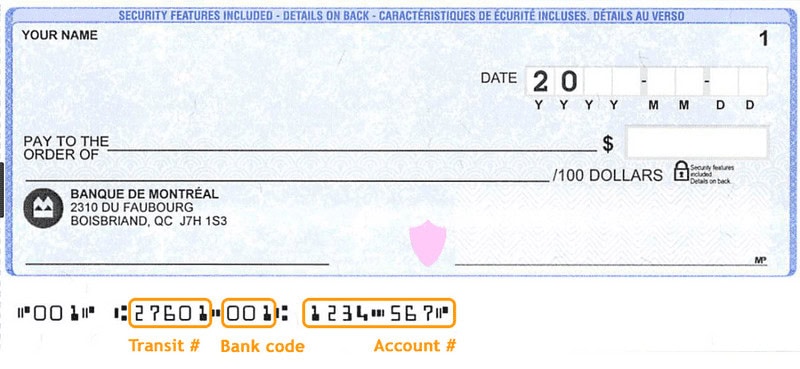
Scotiabank Transit and Account Number
On a Scotiabank cheque, your transit number and institution number appear directly after the cheque number, which is typically the first three digits on the left. Your account number follows after the routing symbols and is split into two grouped sequences.
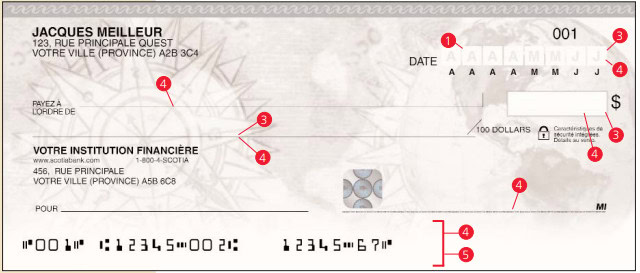
RBC Transit and Account Number
On an RBC cheque, your transit number and institution number appear immediately after the cheque number, which is typically the first three digits. Your account number follows, usually broken into three segments separated by MICR routing symbols.

TD Transit and Account Number
On a TD cheque, your transit number and institution number are located in the middle of the cheque, directly following the cheque number (typically the first three digits). A destination number may follow, and your account number appears as the final set, separated by MICR routing symbols.
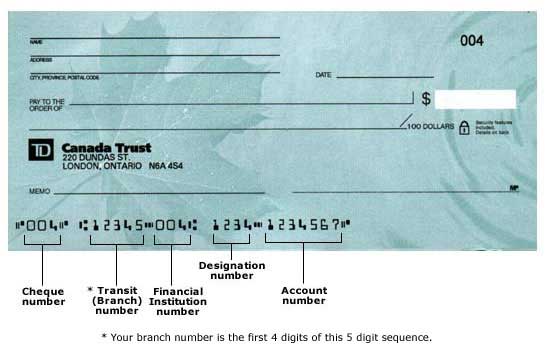
CIBC Transit and Account Number
On a CIBC cheque, your transit number and institution number are located in the center, directly following the cheque number. Your account number appears as the final two groups of digits, divided by routing symbols along the MICR line.
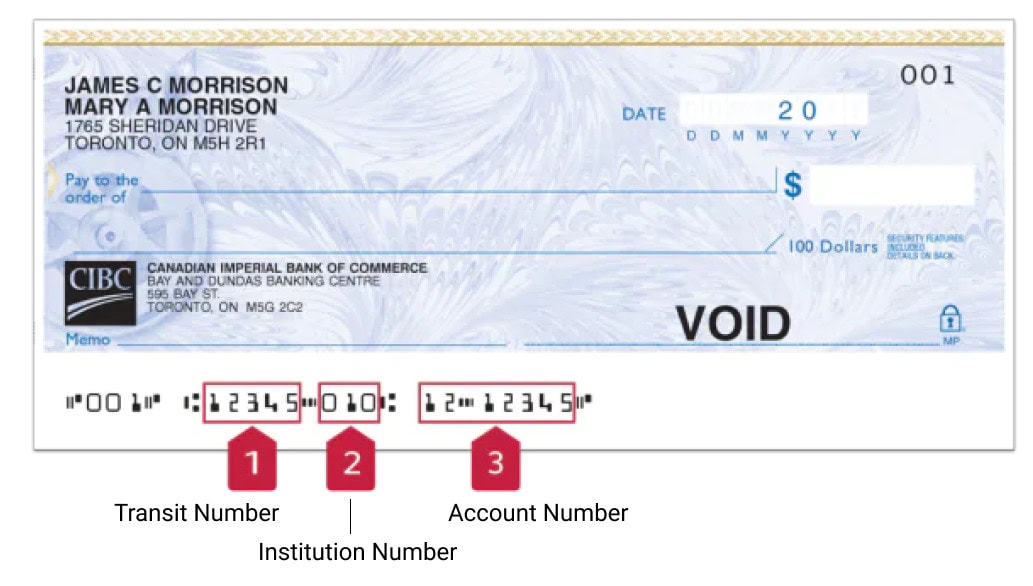
Simplii Financial Transit and Account Number
Simplii Financial is a branchless bank and uses a shared transit number across all customers. Your transit number is 30800 and your institution number is 010. Your account number follows these and is the final sequence, separated by MICR routing symbols on your cheque.
- Log in to Simplii’s online banking via web or mobile app.
- Go to “Account Details” or “Direct Deposit / Void Cheque.”
- Select the account you need details for.
- You’ll see a pre‑filled void cheque or form showing your transit (30800), institution (010), and account numbers.
- For mobile app: tap the account, then tap “Account Info” to view the same details.
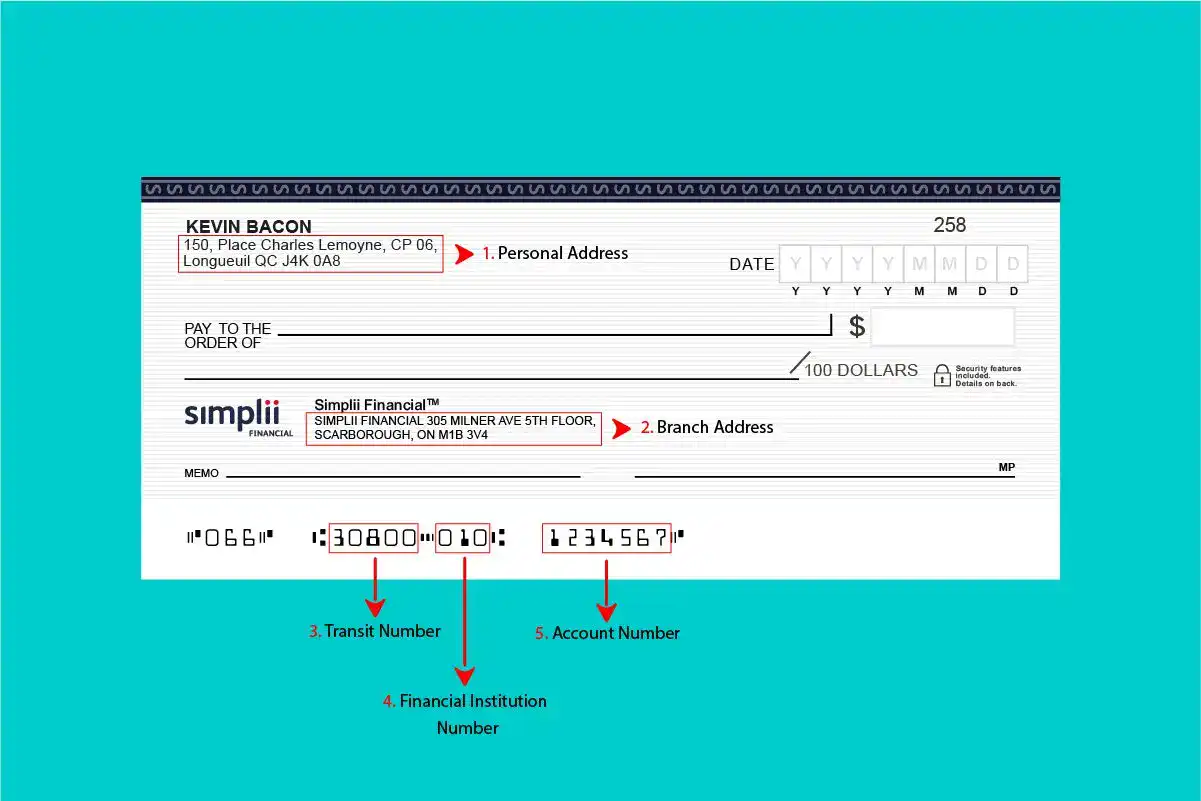
Tangerine Transit and Account Number
On a Tangerine cheque, the transit number is a 5-digit code and the institution number is a 3-digit code, both found near the bottom of the cheque. Your account number follows these and is the final sequence, separated by MICR routing symbols.

How to find your Institution Number
Your institution number is the easiest part to spot on a cheque or look up online. It’s a three‑digit code that identifies your financial institution, and it’s combined with the transit (branch) number to form your full routing number. Below is a list of institution numbers for Canada’s most commonly used banks and credit unions:
- 001 – Bank of Montreal (BMO)
- 002 – Scotiabank
- 003 – Royal Bank of Canada (RBC)
- 004 – Toronto‑Dominion Bank (TD)
- 006 – National Bank of Canada
- 010 – Canadian Imperial Bank of Commerce (CIBC, including Simplii Financial)
- 016 – HSBC Bank Canada
- 030 – Canadian Western Bank
- 039 – Laurentian Bank of Canada
- 614 – Tangerine Bank
- 608 – Alterna Bank
- 623 – Equitable Bank (EQ Bank)
- 618 – B2B Bank
- 540 – Manulife Bank of Canada
- 837 – Meridian Credit Union
- 809 – Central 1 Credit Union (BC)
- 828 – Central 1 Credit Union (Ontario)
- 815 – Desjardins Group (Quebec)
For a full and up‑to‑date list of institution numbers, visit the official Payments Canada Financial Institution Directory.
Routing Number Formats (MICR vs. ETF)
In Canada, routing numbers are formatted differently depending on the payment method being used. Understanding the difference between MICR and ETF formats helps ensure your banking details are submitted correctly, especially for automatic withdrawals or deposits.
The MICR format (Magnetic Ink Character Recognition) is commonly used for paper cheques. It appears as a string printed along the bottom of the cheque and looks something like this:
00012-003
In this example, 00012 is the transit number and 003 is the institution number.
The ETF format (Electronic Funds Transfer) is used for direct deposits and electronic payments. It combines the same numbers, but without the dash:
300012000
This format starts with the institution number (3-digit) followed by the transit number (5-digit).
If you’re submitting your routing details for insurance premiums, investment transfers, or any kind of automated payment, make sure you’re using the right format for the type of form. Most pre-authorized debit forms use the ETF version.
Routing Numbers for International Transfers (SWIFT and IBAN)
Canadian banks do not use IBANs (International Bank Account Numbers), but instead rely on SWIFT codes for international wire transfers. A SWIFT code is an 8 or 11-character identifier for banks and is required when receiving money from overseas.
Each bank has a specific SWIFT code. For example:
- TD Canada Trust: TDOMCATTTOR
- RBC: ROYCCAT2
- Scotiabank: NOSCCATT
- BMO: BOFMCAM2
- CIBC: CIBCCATT
To receive a wire transfer internationally, you’ll typically need:
- Your full name and address
- Your bank account number
- Your bank’s SWIFT code
- Your bank’s full name and address
Always verify this information with your financial institution before initiating a transfer. If any detail is incorrect, the transfer could be delayed or rejected.
Routing Info on Direct Deposit & Government Forms
Many Canadian institutions, including employers, insurance providers, and government agencies like the CRA, require your banking details to process direct deposits or automatic withdrawals. These forms typically ask for:
- Your bank’s routing number (institution + transit number)
- Your account number
- Sometimes the name and address of your financial institution
You can usually download a void cheque or direct deposit form from your online banking account. This ensures you enter accurate details and helps prevent missed payments or delays.
If you’re filling out a government form like the T1-DD – Direct Deposit Request, attach your void cheque or complete the banking section using the numbers from your cheque or bank portal.
FAQ – Frequently Asked Questions
How do I find my bank routing, transit, and account numbers?
These numbers are usually printed on the bottom of your cheque or can be found in your online banking account. The transit number is 5 digits, the institution number is 3 digits, and the account number is typically 7 to 12 digits. Most banks display all of these in the account details section or in a downloadable direct deposit form.
Can I get my routing number without a cheque?
Yes. All major Canadian banks allow you to find your routing number through online or mobile banking. Look for options like “Account Details” or “Direct Deposit Info.” You can also use the Payments Canada branch directory if you know your branch address.
What’s the difference between a routing number and an account number?
The routing number identifies your bank and branch, while the account number is unique to your individual bank account. Both are required to complete automated payments, deposits, or transfers.
Where do I find my institution number for banks like TD, RBC, or Scotiabank?
Institution numbers are standardized 3-digit codes assigned to each Canadian bank. For example, TD is 004, RBC is 003, and Scotiabank is 002. These numbers are also printed on cheques and listed in your account details online.
What if my online banking shows a different routing number than my cheque?
This can happen due to centralized processing or mobile-only accounts. Double-check that your branch and institution numbers match the bank’s official listings. You can always confirm using the Payments Canada directory or by calling your bank directly.
Is the routing number the same for direct deposit and bill payments?
Yes, your routing number (transit + institution number) is the same for most types of electronic transactions, including direct deposits, pre-authorized debits, and bill payments.
Need financial planning or have other financial questions?
Talking to a professional financial advisor can help you navigate any financial situation you may be facing. At Protect Your Wealth, we would be more than happy to provide further analysis for your specific circumstances. We’ve been providing expert advice for financial planning, including retirement planning and life insurance solutions since 2007, such as term life insurance and no medical life insurance. Or, if you are interested in learning more about these options available to you, check out our guide on the best life insurance companies in Canada.
Contact Protect Your Wealth or call us at 1-877-654-6119 to talk to an advisor today. We’re proudly based out of Hamilton, and service clients anywhere in Ontario, British Columbia, and Alberta, including areas such as Guelph, Surrey, and Red Deer.






